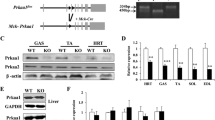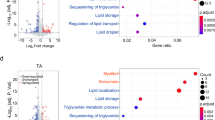Abstract
The phosphoinositide phosphatase, myotubularin-related protein 14 (MTMR14), has been reported to play an important role in the regulation of muscle performance, autophagy, and aging in mice. We previously showed that MTMR14-knockout (KO) mice gain weight earlier than their wild-type (WT) littermates even on a normal chow diet (NCD), suggesting that this gene might also be involved in regulating metabolism. In the present study, we evaluated the effect of MTMR14 deficiency on high-fat diet (HFD)-induced obesity, lipid accumulation, metabolic disorders, and inflammation in WT and MTMR14-KO mice fed with NCD or HFD. To this end, MTMR14-KO mice fed with HFD showed significantly increased body weight, blood glucose levels, serum triglyceride (TG) levels, and total cholesterol (TC) levels as compared to their age-matched WT control. Additionally, lipid accumulation also increased in the KO mice. Simultaneously, the expression of metabolism-associated genes (Glut4, adiponectin, and leptin) was different in the liver, muscle, and fatty tissue of MTMR14-KO mice fed with HFD. More importantly, the expression of several inflammation-associated genes (TNF-α, IL-6, IL-1β, and MCP-1) dramatically increased in the liver, muscle, and fatty tissue of MTMR14-KO mice relative to control. Taken together, these results suggest that MTMR14 deficiency accelerates HFD-induced metabolic dysfunction and inflammation. Furthermore, the results showed that exacerbated metabolic dysfunction and inflammation may be regulated via the PI3K/Akt and ERK signaling pathways.








Similar content being viewed by others
References
Albuquerque D, Stice E, Rodriguez-Lopez R, Manco L, Nobrega C (2015) Current review of genetics of human obesity: from molecular mechanisms to an evolutionary perspective. Mol Genet Genomics 290:1191–1221
Amoasii L, Hnia K, Laporte J (2012) Myotubularin phosphoinositide phosphatases in human diseases. Curr Top Microbiol Immunol 362:209–233
Andel M, Polak J, Kraml P, Dlouhy P, Stich V (2009) Chronic mild inflammation links obesity, metabolic syndrome, atherosclerosis and diabetes. Vnitr Lek 55:659–665
Biswas SK, Mantovani A (2012) Orchestration of metabolism by macrophages. Cell Metab 15:432–437
Clemmensen C, Smajilovic S, Madsen AN, Klein AB, Holst B, Brauner-Osborne H (2013) Increased susceptibility to diet-induced obesity in GPRC6A receptor knockout mice. J Endocrinol 217:151–160
DePaoli AM (2014) 20 years of leptin: leptin in common obesity and associated disorders of metabolism. J Endocrinol 223:T71–81
Dowling JJ, Low SE, Busta AS, Feldman EL (2010) Zebrafish MTMR14 is required for excitation-contraction coupling, developmental motor function and the regulation of autophagy. Hum Mol Genet 19:2668–2681
Fortuno A, Rodriguez A, Gomez-Ambrosi J, Fruhbeck G, Diez J (2003) Adipose tissue as an endocrine organ: role of leptin and adiponectin in the pathogenesis of cardiovascular diseases. J Physiol Biochem 59:51–60
Gibbs EM, Feldman EL, Dowling JJ (2010) The role of MTMR14 in autophagy and in muscle disease. Autophagy 6:819–820
Guerre-Millo M (2008) Adiponectin: an update. Diabetes Metab 34:12–18
Hanson C, Rutten EP, Wouters EF, Rennard S (2014) Influence of diet and obesity on COPD development and outcomes. Int J Chron Obstruct Pulmon Dis 9:723–733
Hnia K, Kretz C, Amoasii L, Bohm J, Liu X, Messaddeq N, Qu CK, Laporte J (2012) Primary T-tubule and autophagy defects in the phosphoinositide phosphatase Jumpy/MTMR14 knockout mice muscle. Advances in biological regulation 52:98–107
Jasik CB (2014) Body image and health: eating disorders and obesity. Prim Care 41:519–537
Karaman S, Hollmen M, Robciuc MR, Alitalo A, Nurmi H, Morf B, Buschle D, Alkan HF, Ochsenbein AM, Alitalo K et al (2015) Blockade of VEGF-C and VEGF-D modulates adipose tissue inflammation and improves metabolic parameters under high-fat diet. Molecular metabolism 4:93–105
Liu X, Huang T, Li L, Tang Y, Tian Y, Wang S, Fan C (2015) CYP1B1 deficiency ameliorates obesity and glucose intolerance induced by high fat diet in adult C57BL/6J mice. American journal of translational research 7:761–771
Lv Y, Xue L, Cai C, Liu QH, Shen J (2015) Deficiency of myotubularin-related protein 14 influences body weight, metabolism, and inflammation in an age-dependent manner. Cell & bioscience 5:69
Maury E, Brichard SM (2010) Adipokine dysregulation, adipose tissue inflammation and metabolic syndrome. Mol Cell Endocrinol 314:1–16
Mikuska L, Vrabcova M, Tillinger A, Balaz M, Ukropec J, Mravec B (2016) Chronic liquid nutrition intake induces obesity and considerable but reversible metabolic alterations in Wistar rats. J Physiol Biochem 72:225–243
Nigro E, Scudiero O, Monaco ML, Palmieri A, Mazzarella G, Costagliola C, Bianco A, Daniele A (2014) New insight into adiponectin role in obesity and obesity-related diseases. Biomed Res Int 2014:658913
Pang J, Rhodes DH, Pini M, Akasheh RT, Castellanos KJ, Cabay RJ, Cooper D, Perretti M, Fantuzzi G (2013) Increased adiposity, dysregulated glucose metabolism and systemic inflammation in Galectin-3 KO mice. PLoS One 8:e57915
Pedersen DJ, Guilherme A, Danai LV, Heyda L, Matevossian A, Cohen J, Nicoloro SM, Straubhaar J, Noh HL, Jung D et al (2015) A major role of insulin in promoting obesity-associated adipose tissue inflammation. Molecular metabolism 4:507–518
Perfield JW 2nd, Lee Y, Shulman GI, Samuel VT, Jurczak MJ, Chang E, Xie C, Tsichlis PN, Obin MS, Greenberg AS (2011) Tumor progression locus 2 (TPL2) regulates obesity-associated inflammation and insulin resistance. Diabetes 60:1168–1176
Powers SK, Reid MB (2010) MIP/MTMR14 and muscle aging. Aging 2:538
Romero-Suarez S, Shen J, Brotto L, Hall T, Mo C, Valdivia HH, Andresen J, Wacker M, Nosek TM, Qu CK et al (2010) Muscle-specific inositide phosphatase (MIP/MTMR14) is reduced with age and its loss accelerates skeletal muscle aging process by altering calcium homeostasis. Aging 2:504–513
Rui L (2014) SH2B1 regulation of energy balance, body weight, and glucose metabolism. World J Diabetes 5:511–526
Shen J, Yu WM, Brotto M, Scherman JA, Guo C, Stoddard C, Nosek TM, Valdivia HH, Qu CK (2009) Deficiency of MIP/MTMR14 phosphatase induces a muscle disorder by disrupting Ca(2+) homeostasis. Nat Cell Biol 11:769–776
Tosch V, Rohde HM, Tronchere H, Zanoteli E, Monroy N, Kretz C, Dondaine N, Payrastre B, Mandel JL, Laporte J (2006) A novel PtdIns3P and PtdIns(3,5)P2 phosphatase with an inactivating variant in centronuclear myopathy. Hum Mol Genet 15:3098–3106
Unger RH, Scherer PE (2010) Gluttony, sloth and the metabolic syndrome: a roadmap to lipotoxicity. Trends Endocrinol Metab 21:345–352
Vergne I, Roberts E, Elmaoued RA, Tosch V, Delgado MA, Proikas-Cezanne T, Laporte J, Deretic V (2009) Control of autophagy initiation by phosphoinositide 3-phosphatase Jumpy. EMBO J 28:2244–2258
Wang XA, Zhang R, Zhang S, Deng S, Jiang D, Zhong J, Yang L, Wang T, Hong S, Guo S et al (2013) Interferon regulatory factor 7 deficiency prevents diet-induced obesity and insulin resistance. Am J Physiol Endocrinol Metab 305:E485–495
Yamaguchi M, Matsui M, Higa R, Yamazaki Y, Ikari A, Miyake M, Miwa M, Ishii S, Sugatani J, Shimizu T (2015) A platelet-activating factor (PAF) receptor deficiency exacerbates diet-induced obesity but PAF/PAF receptor signaling does not contribute to the development of obesity-induced chronic inflammation. Biochem Pharmacol 93:482–495
Yang Z, Chen X, Chen Y, Zhao Q (2015) Decreased irisin secretion contributes to muscle insulin resistance in high-fat diet mice. Int J Clin Exp Pathol 8:6490–6497
Acknowledgments
We would like to thank Dr. Cheng-Kui Qu from Case Western Reserve University for providing MTMR14+/− mice. This project was supported by the Fund for Distinguished Young Scholars of Heibei Province to Jinhua Shen (Grant No. 2012FFA028), Technology Foundation for Selected Overseas Chinese Scholar of Ministry of Personnel of China, National Natural Science Foundation of China (Grant No. 81170227 to Jinhua Shen; 30900816 and 31371307 to Yong-bo Peng), and the Natural Science Foundation of Hubei Province (Grant No. 2014CFC1116 to Yong-bo Peng).
Author information
Authors and Affiliations
Corresponding authors
Additional information
Lv Yin and Peng Yong-bo contributed equally to this work.
Rights and permissions
About this article
Cite this article
Yin, L., Yong-bo, P., Meng-Fei, Y. et al. Mice lacking myotubularin-related protein 14 show accelerated high-fat diet-induced lipid accumulation and inflammation. J Physiol Biochem 73, 17–28 (2017). https://doi.org/10.1007/s13105-016-0520-6
Received:
Accepted:
Published:
Issue Date:
DOI: https://doi.org/10.1007/s13105-016-0520-6




